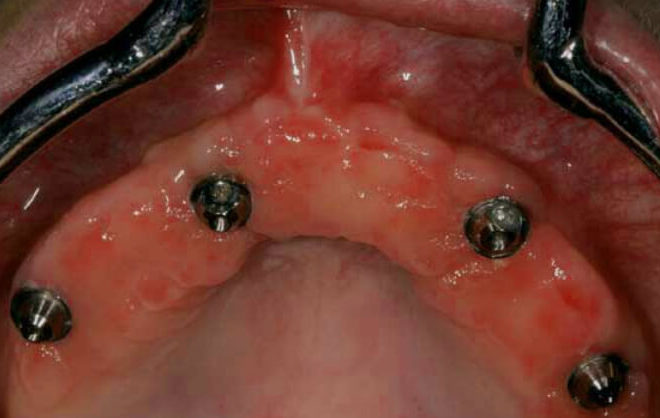IMPLANT RETAINED PROSTHESIS

This is also known as an overdenture that rests on two or more platforms. It can be removed by a dentist and instead of using vacuum to stay in place it rests on clips that are in turn supported by the jaw bone. This is used in people who have all of their upper teeth missing and who also have sufficient jaw bone to hold the dental implants. They are made of denture acrylic. Though they are fixed they can be removed and cleaned by the dentist.
The component of the above denture: The fixture is a small titanium device and resembles a tiny screw. This screw is fixed on the bone by first drilling a hole in the gum and fixes the denture in the hole. These dentures rely on two implants and sometimes there could be four to six implants. Like the conventional dentures they replace your missing teeth and are attached to the implants for more safety and convenience. However they can be removed by the dentist for cleaning.
Are you lacking teeth and struggling with traditional dentures? Implant-retained overdentures are an innovative dental option that is gaining popularity for a reason.
This article digs into the realm of implant-retained overdentures, helping you understand the many retention methods available and how they might improve your smile.
Implant-Retained Overdentures:
Traditional dentures can occasionally slide and cause discomfort. Implant-retained overdentures solve these problems by offering the best of both worlds: a removable denture with strategically placed implants.
These implants serve as anchors, greatly increasing stability and retention. This translates into more confidence while chewing, speaking, and smiling.
Exploring Retention Systems:
The success of your implant-retained overdenture is mainly reliant on the retention strategy you use. This article will examine a number of popular systems, including:
- Locator attachments are a popular choice due to their ease of use and secure fit.
- Ball attachments provide a solid connection and enable multi-directional movement.
- Bar and clip attachments are ideal for situations that require additional support.
We’ll go over the benefits and drawbacks of each system, so you can figure out which one is ideal for you.
Treatment Planning Considerations:
Your dentist must carefully prepare before selecting the best recovery method for you. This article will highlight several important elements examined during the process, including:
- The quantity and location of implants will determine which sort of retention system is most successful.
- Bone health and jaw anatomy: These variables influence implant stability and attachment type.
- Your dentist will review your comfort level, desired amount of stability, and budget before recommending the best solution.
Conclusion:
Implant-retained overdentures offer a life-changing solution for those seeking a comfortable and secure alternative to traditional dentures. By understanding the various retention systems and treatment planning considerations, you can make an informed decision alongside your dentist.


